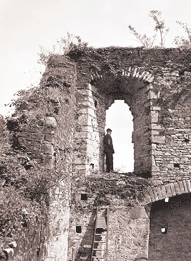Buckfastleigh Wins Campaign to Stop Quarry Dump Site
On 1st March 2012 the Parish Poll took place on the
planning application to allow Whitecleave Quarry in Buckfastleigh to be used
for the processing of ash from the proposed Plymouth waste incinerator. Almost
50% of electorate voted - probably the largest Parish Poll percentage turnout
in history! Results:
95% SAY NO to Waste dump at Whitecleave Quarry
Parish Poll Landslide Result - NO: 1367 YES: 73
After a 4 hour debate on 25th April 2012, Devon
County Council planners voted to turn the application down. None of this would have been possible without the
Buckfastleigh Community Forum. In particular, Forum co-chairs Neil Smith and Julia Walton have worked tirelessly with professionalism
and passion to turn this once 'done deal' around. They brought together
residents, environmental organisations, Dartmoor National Park, the Parish
Council and more, and deserve national recognition for their efforts. The victory proves that people care deeply about their environment and mobilise around significant issues.
 |
| Buckfastleigh c.1830 |
Objections to the quarry are:-
1. Geography
- Whitecleaves Quarry is situated between two planning authorities and is close to the very heart of the town.
- The site is adjacent to residential property which already suffers from noise and air pollution from the A38.
- Such a development would adversely affect local amenity.
- This application would have a significantly negative impact on the socio-economic status of the town.
- There would be a detrimental effect on the town‟s tourism which benefits from 8 significant local attractions and provides significant employment for local people. We would reiterate
that a statutory consultant for the new Teignbridge District Council Plan for 2011 – 2015 which tackles the need for our community and environment and gives new priority and guidelines for economic prosperity, quality, environment and wellbeing. - The site is situated only a few feet from the boundary of Dartmoor National Park Authority.
- We are aware that other developments of this type are situated on established industrial sites with good infrastructure. We would question as to why is it necessary for this development to be sited within a residential rural town on the edge of a National Park and borders the South Hams Area of Conservation.
- Buckfastleigh lies within a stunning valley that suffers from pollution from the A38 which is already exacerbated under certain meteorological conditions.
2. Site Context
- The Town Council has studied the Review of Old Mineral Permissions (ROMP) and Mineral Policy for Devon and searched through our records and we have no sight of a planning application from Gilpins that changes the use of Whitecleaves Quarry to a waste development facility.
- ROMP conditions from 2002 with respect to Whitecleaves Quarry explicitly state that “No materials (or refuse or waste) for the purpose of storage, processing or resale shall be imported in to the site;” this is specifically in order to “prevent the unnecessary increase in traffic attracted to the site in the interest of local amenity and highways safety.” We have not been provided with any evidence that these conditions have been revoked.
- Although we are aware that there is a quarry licence until 2042, the Minerals Policy states it was not commercially viable to continue with quarrying. Blasting dolerite to fill a void can not be classed as quarrying. We also understand that there is no commercial market for dolerite.
- We have had sight of the response to this application by Dartmoor National Park Authority and are in full agreement with the comments made with respect to site arrangement and mitigation.
3. Habitats and Wildlife
- Members are in full agreement with Dartmoor National Park Authority and Natural England regarding the potential impact on habitats and wildlife in this area.
- It should be noted that we are fortunate to have a variety of protected species living in the vicinity of the quarry. This proposal contravenes the protection afforded by current legislation and the legality of disturbing the established habitat of protected species should be questioned.
4. Site Access and Impact on Road Safety
- There will be a significant increase of movement from HGVs in and out of this site which is accessed from a residential road.
- We are very concerned for the safety of cyclists, pedestrians and other road users.
- There will be a substantial increase in the number of HGVs from when Hansons were quarrying. Since then there has been further residential development which in itself generates more traffic.
- We are extremely concerned that this will effectively split community cohesion between the east and west of the town.
- The A38 was constructed in the early 1970‟s when nationally there was a significantly lower level of traffic volume and movement. We have grave concerns that the stability and structural integrity of this road and the viaduct adjacent to the quarry site will be severely compromised by the impact of blasting.
5. Site Activity
After carefully considering this application there is a lot of vague statements regarding the following:-
- The classification of Incinerator Bottom Ash toxic or non toxic
- The regularity of samplin
- The average number of lorry trips“minor impact or little significance” which does not take into account cumulative effect
- Lack of accurate information concerning the drainage system currently in the quarry
- Lack of information regarding dust suppression measures, we do not believe that the mitigating measures for dust suppression is robust enough.
6. Environmental Impact
a) Contamination – Land and Water Quality
- The Dean Burn water course has tested in the past as having water quality „A‟ as classified through the Environment Agency General Quality Assessment Process.
- The list of pollution incidents of the Dean Burn applies to the 1990s.
- The indicative drainage layout diagram shows water running into an existing open drainage ditch.
- There is no diagram of the existing drainage system within the quarry.
b) Air Quality
- The proposed development is likely to lead to visible emissions of dust as stated 12.3.13 occurring at the source on a regular basis, due to the number of potentially dust generated activities being undertaken across the site. The Town Council are concerned that air quality will not be continually monitored even if all mitigating proposals are put in place because the risk is deemed low.
c) Noise Pollution
- It is difficult to get an accurate figure for HGV movement on Strode Road from the planning application, but it is estimated at 100 lorries per day. There is also the increase of traffic on the A38 from other planned waste facilities throughout Devon and Cornwall.The application states that dolerite will be blasted from inside the quarry to fill the void and level the site in preparation for the Incinerated Bottom Ash facility. We believe this spur of rock within the quarry with tree screening appears to protect Buckfastleigh from excessive noise levels, particularly as there will be a mobile crusher inside the quarry and other sound generating equipment.











































